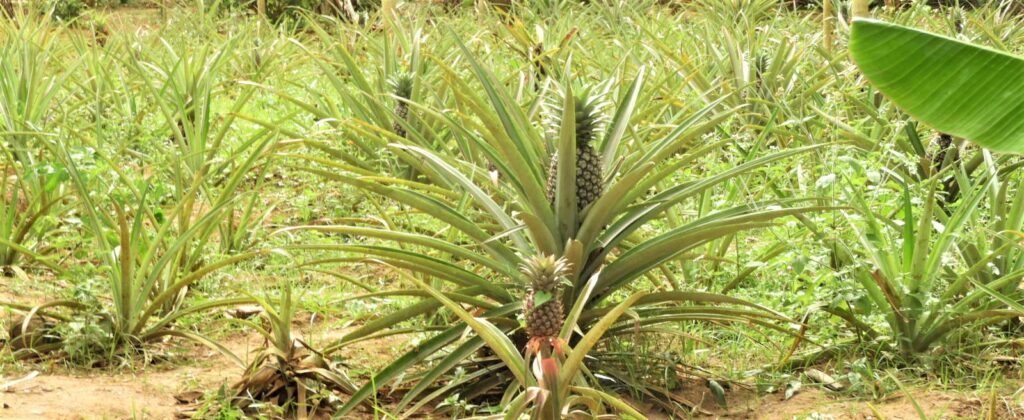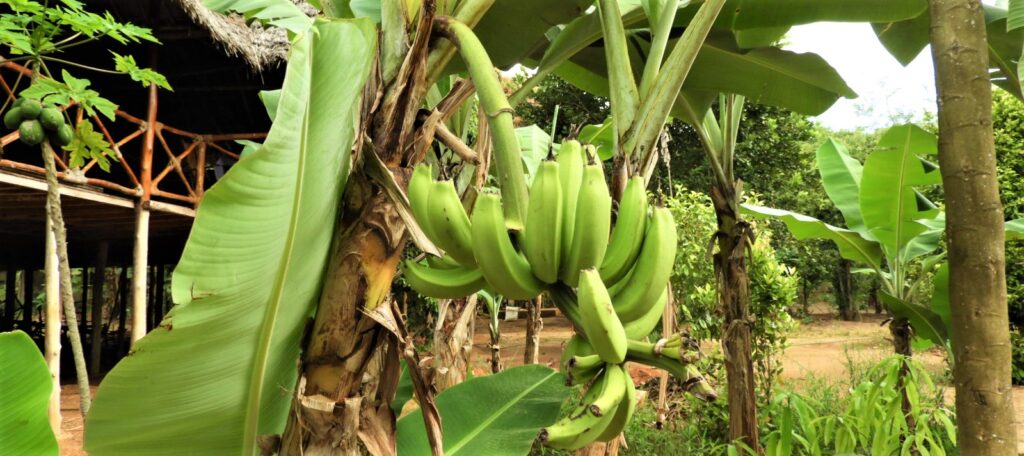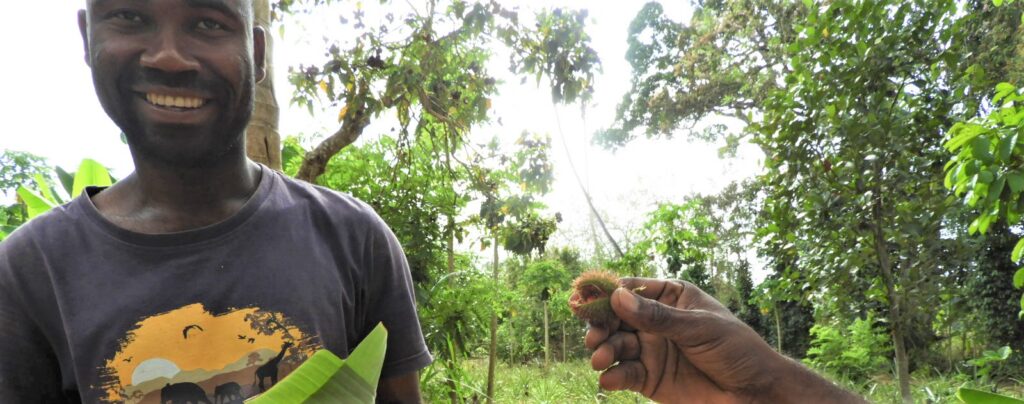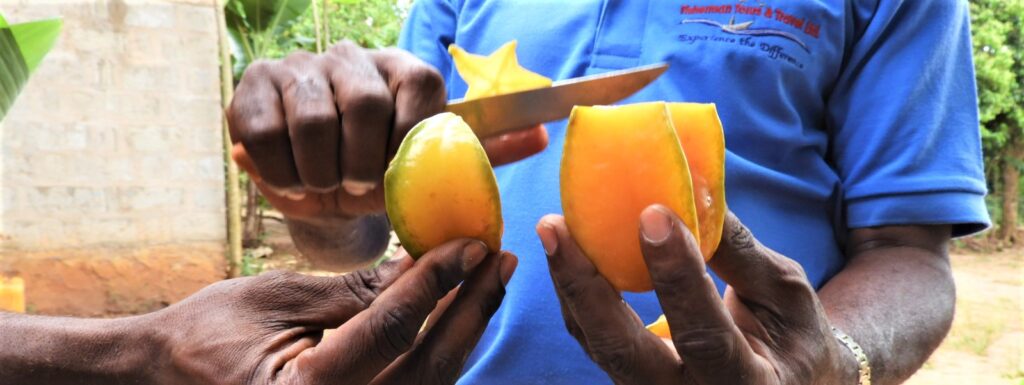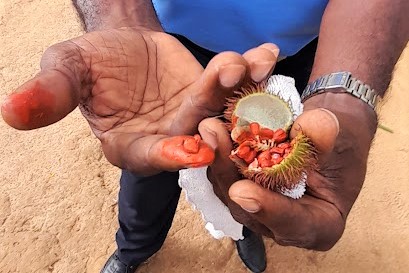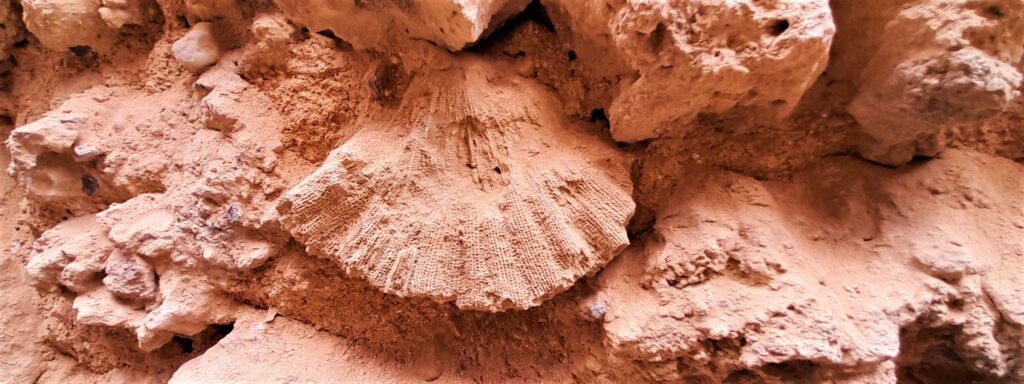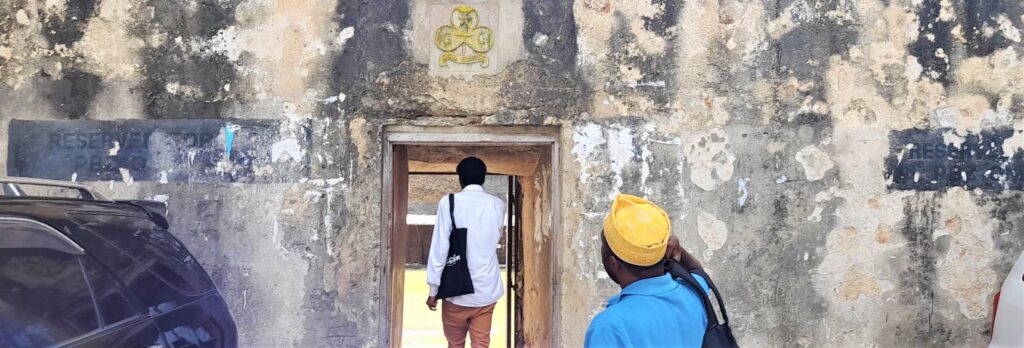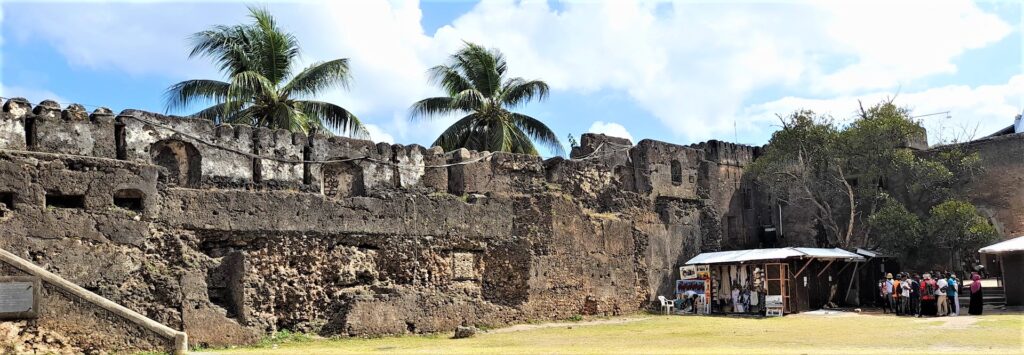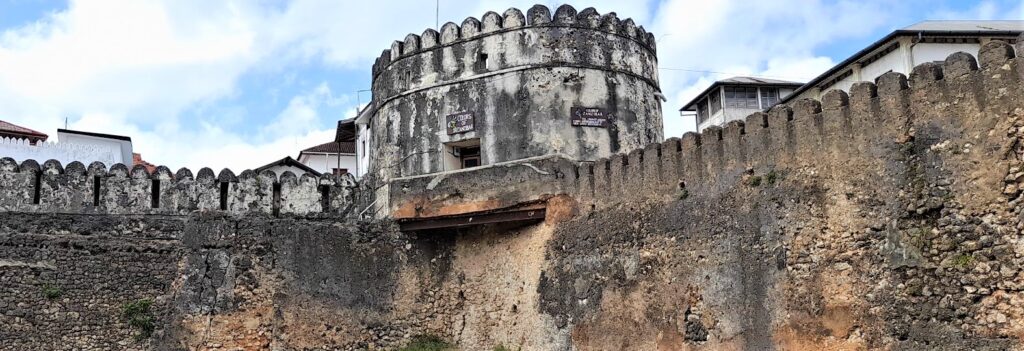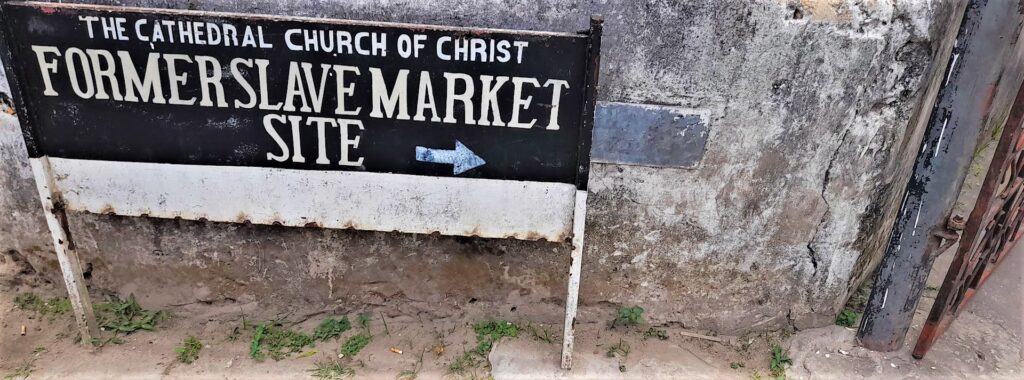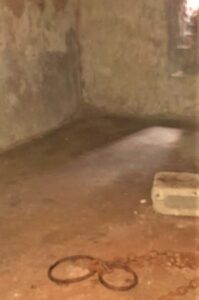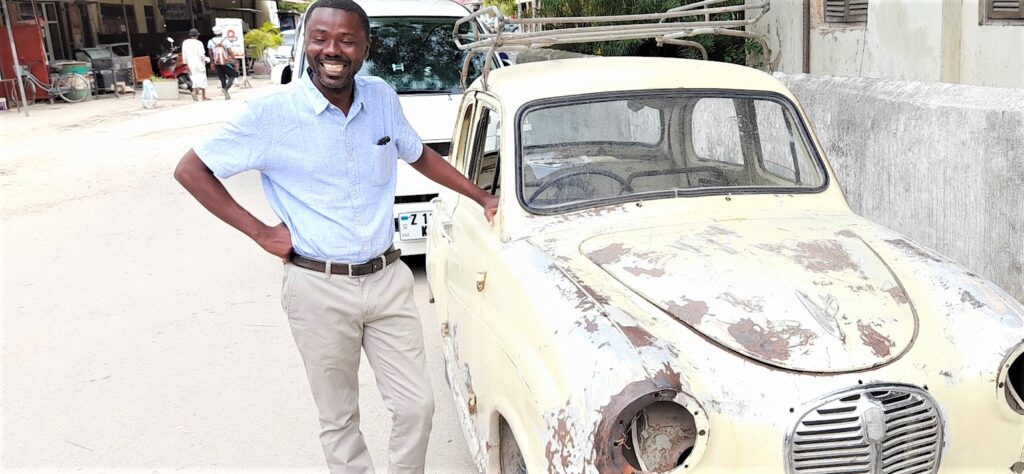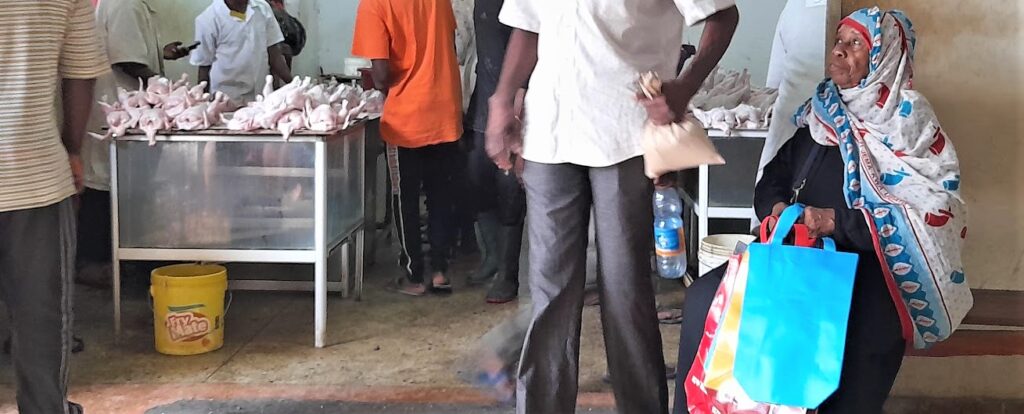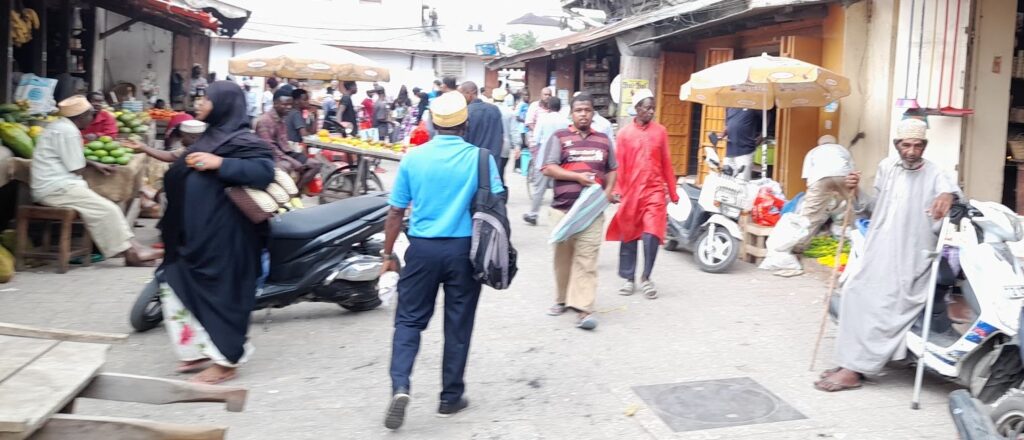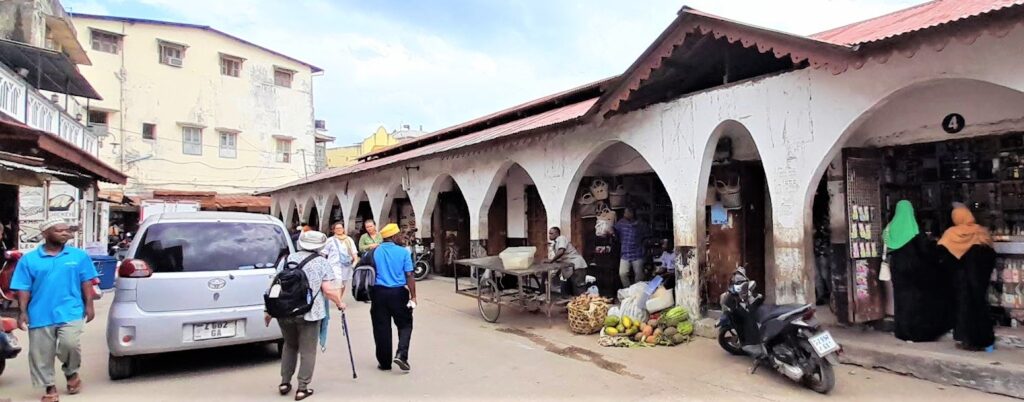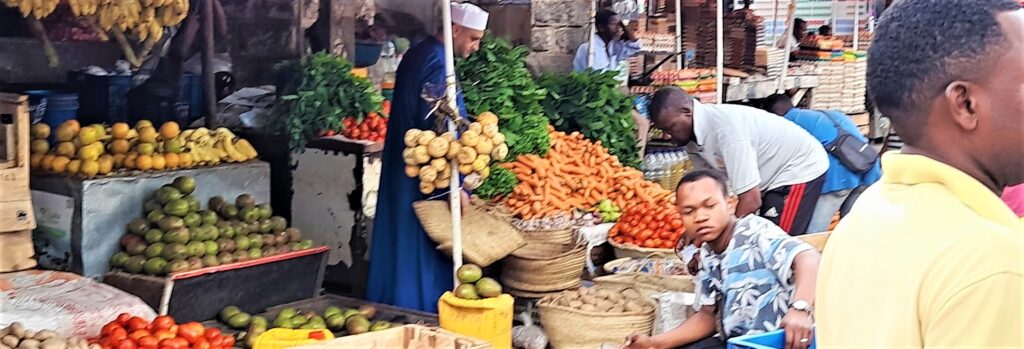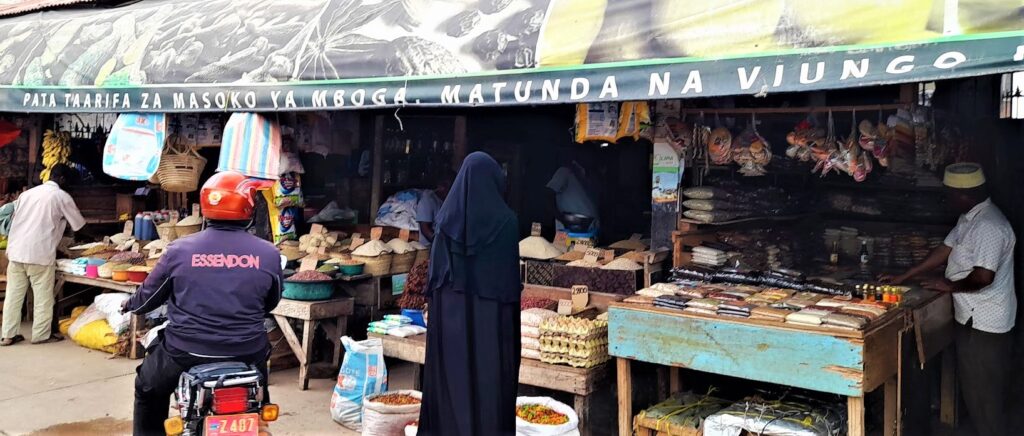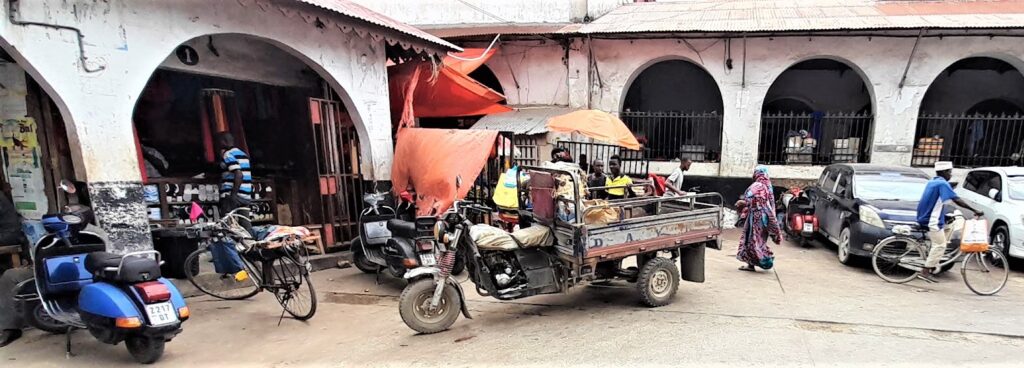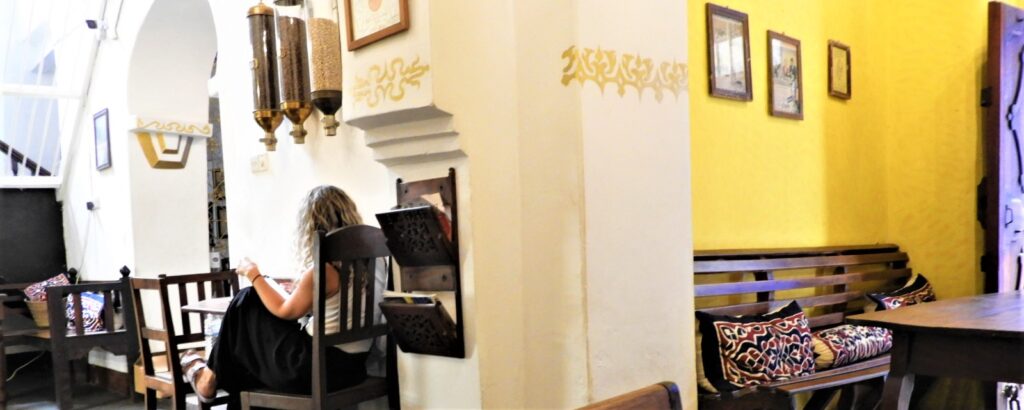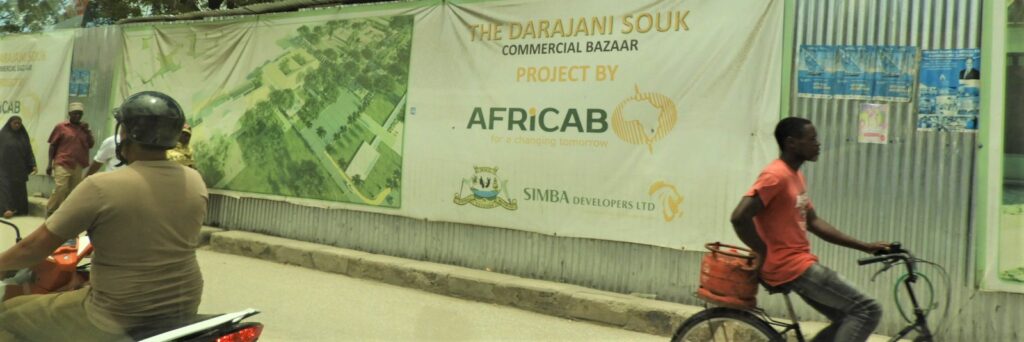Archive for September 26th, 2022
» posted on Monday, September 26th, 2022 by Linda Lou Burton
A Spicy Afternoon
Linda Lou Burton posting from Zanzibar Serena Hotel, Stone Town, Zanzibar, Tanzania – 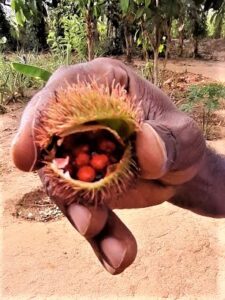 Cinnamon is tree bark. A pineapple plant produces only ONE pineapple. And the lipstick tree (no, I’m not kidding) has little red berries inside its spiny smooch-smooch pod that some people (have been known to) use to redden their lips. All of this was news to me! Cinnamon is TREE BARK? That’s right, that beloved wonderful-smelling stuff Mother would sprinkle on toast for me (a picky-eater-kid) comes from the bark of a tree. Imagine this: you scrape off the outer bark of a cinnamon tree (it’s an evergreen); then you cut out the inner bark, in strips. As the bark dries, it rolls into a
Cinnamon is tree bark. A pineapple plant produces only ONE pineapple. And the lipstick tree (no, I’m not kidding) has little red berries inside its spiny smooch-smooch pod that some people (have been known to) use to redden their lips. All of this was news to me! Cinnamon is TREE BARK? That’s right, that beloved wonderful-smelling stuff Mother would sprinkle on toast for me (a picky-eater-kid) comes from the bark of a tree. Imagine this: you scrape off the outer bark of a cinnamon tree (it’s an evergreen); then you cut out the inner bark, in strips. As the bark dries, it rolls into a  curl. The dried curls are cut into “quills” 2-4 inches long for sale. Somehow or other this delicious tree bark winds up powdered on bread making cinnamon toast for picky kids. Or cinnamon rolls for everybody. We couldn’t even have Halloween Red Hots without that fragrant tree bark! That’s just part of what we learned this afternoon at the Jambo Spice Farm, where things that sit in everybody’s kitchen cabinet take on an exotic aura. Like cloves, the “Emperor of Spices”; like nutmeg, turmeric, cardamom, black pepper. You should have been there!
curl. The dried curls are cut into “quills” 2-4 inches long for sale. Somehow or other this delicious tree bark winds up powdered on bread making cinnamon toast for picky kids. Or cinnamon rolls for everybody. We couldn’t even have Halloween Red Hots without that fragrant tree bark! That’s just part of what we learned this afternoon at the Jambo Spice Farm, where things that sit in everybody’s kitchen cabinet take on an exotic aura. Like cloves, the “Emperor of Spices”; like nutmeg, turmeric, cardamom, black pepper. You should have been there!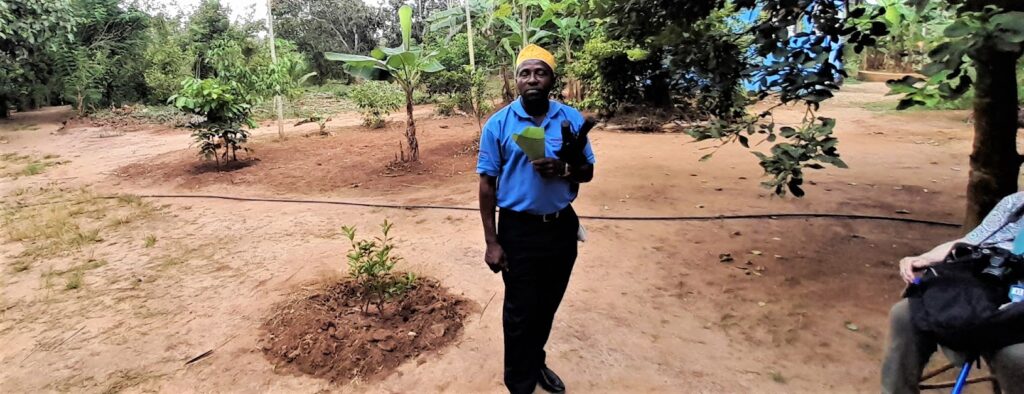
Ali drove, and Said led the tour, along with locals on the farm; a jungley maze of green to wander through on a warm afternoon. No crowds, no hurry, just stop, look, smell, and taste. Touch a banana while it’s hanging on the tree, still growing. Watch a brave soul shimmy up a 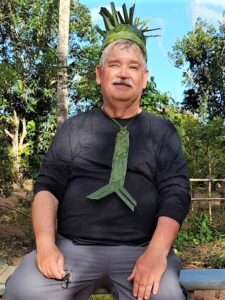 coconut tree while everyone below chants him higher, higher, daring. Rick wound up with a hat and a tie made of woven coconut leaves (and he didn’t have to climb the tree). I gained a new appreciation for the gardening tactics regarding pineapple. Cut off the top and plant it so it can make another plant. Eat the pineapple fruit. Repeat. As for the lipstick tree: those bright red berries actually are used in industrial dyes for food preparation and cosmetics. My vote for prettiest just-off-the-tree spice was the nutmeg – once you open the outer shell it looks like you’ve lucked into a fancily-decorated chocolate bon-bon. Don’t you think?
coconut tree while everyone below chants him higher, higher, daring. Rick wound up with a hat and a tie made of woven coconut leaves (and he didn’t have to climb the tree). I gained a new appreciation for the gardening tactics regarding pineapple. Cut off the top and plant it so it can make another plant. Eat the pineapple fruit. Repeat. As for the lipstick tree: those bright red berries actually are used in industrial dyes for food preparation and cosmetics. My vote for prettiest just-off-the-tree spice was the nutmeg – once you open the outer shell it looks like you’ve lucked into a fancily-decorated chocolate bon-bon. Don’t you think?
Jambo Spice Farm is a 30-minute drive from Stone Town, in a cluster of spice-growing farms – Abeid, Badru, SISO, Tangawizi; and near the Zanzibar Agricultural Research Institute and the School of Agriculture. The drive passes along the coastline, turning eastward at Bububu.
Why do spices grow so profusely in Zanzibar? Perfect soil and climate – plenty of rain and always, always warm.
Zanzibar Serena Hotel https://www.serenahotels.com/zanzibar
Fisherman’s Tours https://fishermantours.com/
Zanzibar School of Agriculture https://suza.ac.tz/soa/
Next Post: The Guard Made The Day
» posted on Monday, September 26th, 2022 by Linda Lou Burton
Food, Facts, & A Fort
Linda Lou Burton posting from Zanzibar Serena Hotel, Stone Town, Zanzibar, Tanzania – Who doesn’t love pizza? The minute I saw “pizza” on the menu I knew that’s what I was ordering. I’d read about “Zanzibar Pizza” and was dying to try it – not Italian pizza, but Zanzibar pizza. You take unleavened dough, stretch it thin and fill it with beef, chicken, seafood, vegetables, cheese, eggs, whatever you please. Then you wrap the sides around, throw it into a pan full of butter, and fry it to a crispy gold! You can also make it sweet: bananas, mangoes, chocolate spread, even peanut butter. We’d had our Zanzibar coffee  earlier, now with the Walking Tour done, Rick and I were in a tiny restaurant-by-the-sea for our lunch break. Said and Ali would fetch us later for our ride south to the Spice Farm. Lots to talk about – Rick had wandered through several hundred years of civilization in the last few hours. Stone Town is on Unguja, the largest of the Zanzibar Archipelago’s four main islands; it is 53 miles long and 24 miles wide, about 25 miles from Tanzania’s mainland. Zanzibar’s population (all islands) is under 2 million. Zanzibar City, of which Stone Town is a part, is the capital of this semi-autonomous province-within-a-country. That’s the geography. We needed to get Zanzibar’s HISTORY unscrambled in our heads, so, dates next.
earlier, now with the Walking Tour done, Rick and I were in a tiny restaurant-by-the-sea for our lunch break. Said and Ali would fetch us later for our ride south to the Spice Farm. Lots to talk about – Rick had wandered through several hundred years of civilization in the last few hours. Stone Town is on Unguja, the largest of the Zanzibar Archipelago’s four main islands; it is 53 miles long and 24 miles wide, about 25 miles from Tanzania’s mainland. Zanzibar’s population (all islands) is under 2 million. Zanzibar City, of which Stone Town is a part, is the capital of this semi-autonomous province-within-a-country. That’s the geography. We needed to get Zanzibar’s HISTORY unscrambled in our heads, so, dates next.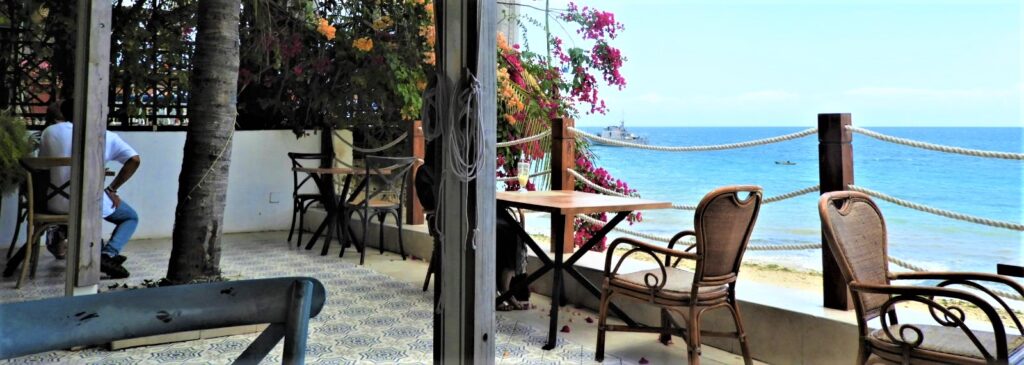
10 Significant Dates (among many!):
- 1498 – Portugal’s Vasco da Gama visited the islands
- 1571 – Zanzibar became part of the Portuguese Empire
- 1635 – Portuguese established a fort on Pemba Island
- 1698 – Zanzibar came under influence of the Sultan of Oman
- 1699 –Omani’s expelled the Portuguese, built fort in Stone Town
- 1784 – Brief revolt against Omani rule
- 1890 – Zanzibar became a protectorate of Great Britain
- 1963 – British protectorate terminated, Zanzibar became monarchy
- 1964 – Sultan deposed, Zanzibar became Peoples Republic
- 1964 – Zanzibar merged with Tanganyika to become Tanzania
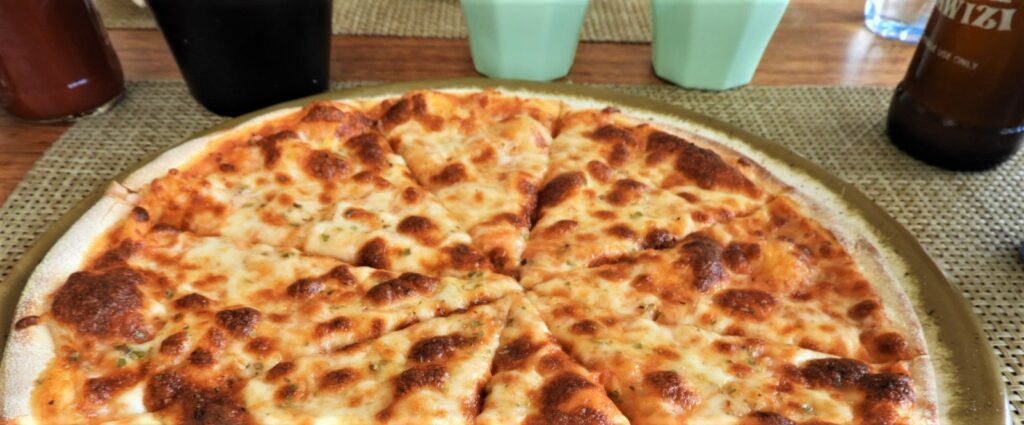 Oops, here are our pizzas, looking very American. “Sorry, we don’t serve Zanzibar pizza here,” our server explained. Okay then, something familiar! “Just tell me about two things you saw this morning,” I said to Rick as I scarfed down my cheesy pizza. “Your favorites.”
Oops, here are our pizzas, looking very American. “Sorry, we don’t serve Zanzibar pizza here,” our server explained. Okay then, something familiar! “Just tell me about two things you saw this morning,” I said to Rick as I scarfed down my cheesy pizza. “Your favorites.”
His picks: the coral stone used for building construction and the Old Fort.
Stone Town was named “Stone Town” because its buildings were mainly built with coral stone, giving the town a warm color. Look at this alley wall!
The Old Fort is on the main seafront, by the House of Wonders, facing Forodhani Gardens. History: it was built by Omani Arabs after chasing away the Portuguese in 1699. It was used as a garrison and prison in the 19th century. In the early 20th century it was a depot as the railway that connected Stone Town to the village of Bububu (named for the sound a steam engine makes as it passes by bububububu) was being constructed. A new guardhouse was built in 1947 and used as the ladies’ club. And, thoroughly modern — its amphitheater is now the headquarters of the Zanzibar international film festival!
Zanzibar Serena Hotel https://www.serenahotels.com/zanzibar
Fisherman’s Tours https://fishermantours.com/
Next Post: A Spicy Afternoon
» posted on Monday, September 26th, 2022 by Linda Lou Burton
Sultans and Slavers
Linda Lou Burton posting from Zanzibar Serena Hotel, Stone Town, Zanzibar, Tanzania – “A fabled land of spices and a vile center of slavery.” That was Zanzibar’s world-wide reputation back in the 19th century. It was, in fact, the main slave-trading port of the African Great Lakes region; as many as 50,000 slaves were passed through the slave markets of Zanzibar each year. David Livingstone, a British missionary and explorer, estimated that 80,000 new slaves died each year before ever reaching the island. Tippu Tip was the most notorious slaver, under several sultans, and also a trader, plantation owner, and governor. 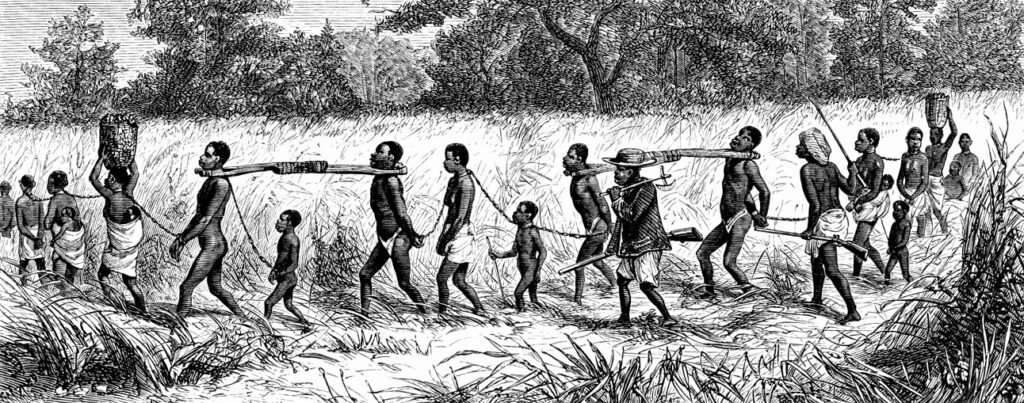 The United Kingdom’s early interest in Zanzibar was motivated both by commerce (all those spices) and by the determination to end the slave trade. In 1822, the British signed the first of a series of treaties with Zanzibar Sultans to curb this trade; the slave trade was officially abolished in 1876 during the rule of Sultan Barghash although slavery itself remained legal in Zanzibar until 1897. Take a look at two main players on the Zanzibari stage.
The United Kingdom’s early interest in Zanzibar was motivated both by commerce (all those spices) and by the determination to end the slave trade. In 1822, the British signed the first of a series of treaties with Zanzibar Sultans to curb this trade; the slave trade was officially abolished in 1876 during the rule of Sultan Barghash although slavery itself remained legal in Zanzibar until 1897. Take a look at two main players on the Zanzibari stage.
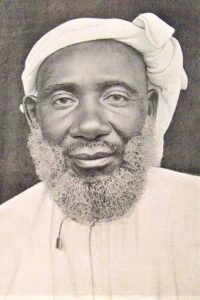 Tippu. Tippu Tip (1832-1905) was an Afro-Omani ivory and slave trader who was born and died in Zanzibar. His real name is longer than I have space for so I’ll use his nickname, which kind of sticks in your head anyway. Tippu Tib, as he was first known, translates to “gatherer together of wealth;” the “Tib” changed to “Tip” because of the “tiptip” sound his guns made during his expeditions. At least, that’s his claim; he wrote a book about himself which was published in Britain in 1907. Either nickname fits; Tippu became a wealthy man trading in slaves for Zanzibar’s clove plantations. He led many expeditions into Central Africa, establishing profitable trading posts deep into the Congo Basin. Between 1884 and 1887 he claimed the Eastern Congo for himself and for the Sultan of Zanzibar, Barghash bin Said el Busaidi. By 1895, he had acquired seven plantations and 10,000 slaves. He became the most well-known slave trader in Africa, supplying much of the world with black slaves.
Tippu. Tippu Tip (1832-1905) was an Afro-Omani ivory and slave trader who was born and died in Zanzibar. His real name is longer than I have space for so I’ll use his nickname, which kind of sticks in your head anyway. Tippu Tib, as he was first known, translates to “gatherer together of wealth;” the “Tib” changed to “Tip” because of the “tiptip” sound his guns made during his expeditions. At least, that’s his claim; he wrote a book about himself which was published in Britain in 1907. Either nickname fits; Tippu became a wealthy man trading in slaves for Zanzibar’s clove plantations. He led many expeditions into Central Africa, establishing profitable trading posts deep into the Congo Basin. Between 1884 and 1887 he claimed the Eastern Congo for himself and for the Sultan of Zanzibar, Barghash bin Said el Busaidi. By 1895, he had acquired seven plantations and 10,000 slaves. He became the most well-known slave trader in Africa, supplying much of the world with black slaves.
 Barghash. Barghash bin Said al-Busaidi (1836-1888) was an Omani Sultan and the second Sultan of Zanzibar, ruling from October 7, 1870 to March 26, 1888. Described as having a sharp and charming character, he is credited with building much of the infrastructure of Stone Town, including piped water, public baths, a police force, roads, parks, hospital, and large administrative buildings such as the House of Wonders. Barghash had a treaty with the British to help stop the slave trade in Zanzibar, but did not always keep his commitment. In June 1873 John Kirk, acting British Consul, received contradictory instructions from London; one to issue an ultimatum to the Sultan that the slave trade must be stopped and the slave market closed, under threat of blockade; the other not to enforce a blockade which might be taken as an act of war. Kirk showed only the first instruction to Barghash, who capitulated, signing a further treaty with Britain prohibiting slave trade in his kingdom, and immediately closing the slave market.
Barghash. Barghash bin Said al-Busaidi (1836-1888) was an Omani Sultan and the second Sultan of Zanzibar, ruling from October 7, 1870 to March 26, 1888. Described as having a sharp and charming character, he is credited with building much of the infrastructure of Stone Town, including piped water, public baths, a police force, roads, parks, hospital, and large administrative buildings such as the House of Wonders. Barghash had a treaty with the British to help stop the slave trade in Zanzibar, but did not always keep his commitment. In June 1873 John Kirk, acting British Consul, received contradictory instructions from London; one to issue an ultimatum to the Sultan that the slave trade must be stopped and the slave market closed, under threat of blockade; the other not to enforce a blockade which might be taken as an act of war. Kirk showed only the first instruction to Barghash, who capitulated, signing a further treaty with Britain prohibiting slave trade in his kingdom, and immediately closing the slave market.
There are 1,709 buildings in Stone Town, a UNESCO World Heritage Site. Major buildings include Christ Church Anglican Cathedral commemorating the work of David Livingstone in abolishing the slave trade and built on the site of the last slave market; the residence of slave trader Tippu Tip; and the House of Wonders, the large ceremonial palace built by Sultan Barghash; all included in Rick’s Walking Tour this morning. I’ll start with the church. 
The church is located in Mkunazini Road, in the center of the old town, and occupies a large area where the biggest slave market of Zanzibar used to be; its construction was to celebrate the end of slavery. The altar is said to be in the exact place where the main “whipping post” of the market was. In the square there is a monument to the slaves showing human figures in chains emerging from a pit.
The last two buildings are the former home of Tippu Tip, and the House of Wonders. Although Stone Town was included in UNESCO’s World Sites in 2000, this designation does not provide complete protection for the town’s heritage. About 80% of the 1,709 buildings are in a deteriorating condition. Some major restoration projects, especially on the seafront, have been done in recent times by the Aga Khan Trust for Culture.
Zanzibar Serena Hotel https://www.serenahotels.com/zanzibar
Fisherman’s Tours https://fishermantours.com/
Next Post: Food, Facts & A Fort
» posted on Monday, September 26th, 2022 by Linda Lou Burton
To Market, To Market
Linda Lou Burton posting from Zanzibar Serena Hotel, Stone Town, Zanzibar, Tanzania –  A fat pig is about the only thing I didn’t see in Darajani Market this morning. Zanzibar is 99% Muslim, and since pork isn’t an approved dietary item in the Islamic religion, you wouldn’t expect to see it in local stores, or on restaurant menus. Beef, chicken, and goat are on the approved list, as well as seafood; so in a country right on the ocean’s coastline, it makes sense that the Fish Market was the first spot I caught a whiff of. The “morning catch”? I’d watched the fishing boats from my porch at
A fat pig is about the only thing I didn’t see in Darajani Market this morning. Zanzibar is 99% Muslim, and since pork isn’t an approved dietary item in the Islamic religion, you wouldn’t expect to see it in local stores, or on restaurant menus. Beef, chicken, and goat are on the approved list, as well as seafood; so in a country right on the ocean’s coastline, it makes sense that the Fish Market was the first spot I caught a whiff of. The “morning catch”? I’d watched the fishing boats from my porch at 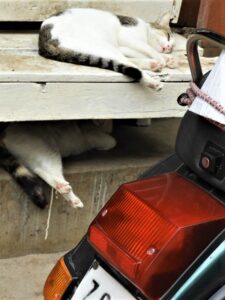 dawn, cruising slowly by, voices likely discussing the catch (good, or bad); is that what I saw in the pile just inside the fishy-smelling building? The market is (understandably) a paradise for cats; as I walked along I spotted cats everywhere; licking their paws, taking a snooze, their little sniffers dreaming sweet, sweet dreams.
dawn, cruising slowly by, voices likely discussing the catch (good, or bad); is that what I saw in the pile just inside the fishy-smelling building? The market is (understandably) a paradise for cats; as I walked along I spotted cats everywhere; licking their paws, taking a snooze, their little sniffers dreaming sweet, sweet dreams.
 I was headed for the Zanzibar Coffee House. Tour Guide Said worked it out with Ali, our driver, to get me as close as possible about the time he and Rick would arrive on the Walking Tour. The “closest” was a 10-minute walk for me (slowly, slowly, pole, pole) through the swirling noise and smells and color where everything was for sale but pig. Spice Island spices, yes. Octopus, changu (a favorite fish), chicken, piles of seafood; bananas, oranges, avocado, pineapple. Shoes. Electronics. What fascinated me most? We’d seen piles of produce and clothing and other tradeable items at markets all the way through Kenya and Tanzania, so crowds and color were not unusual to my eyes. Here though, everything was compressed; tucked into the narrowest of spaces, which seemed to magnify the scene. A dazzling mixture of Arab, Persian, Indian, European and African styles and traditions! Stone Town’s cast of characters is better than a Hollywood movie set. Action! Camera!
I was headed for the Zanzibar Coffee House. Tour Guide Said worked it out with Ali, our driver, to get me as close as possible about the time he and Rick would arrive on the Walking Tour. The “closest” was a 10-minute walk for me (slowly, slowly, pole, pole) through the swirling noise and smells and color where everything was for sale but pig. Spice Island spices, yes. Octopus, changu (a favorite fish), chicken, piles of seafood; bananas, oranges, avocado, pineapple. Shoes. Electronics. What fascinated me most? We’d seen piles of produce and clothing and other tradeable items at markets all the way through Kenya and Tanzania, so crowds and color were not unusual to my eyes. Here though, everything was compressed; tucked into the narrowest of spaces, which seemed to magnify the scene. A dazzling mixture of Arab, Persian, Indian, European and African styles and traditions! Stone Town’s cast of characters is better than a Hollywood movie set. Action! Camera!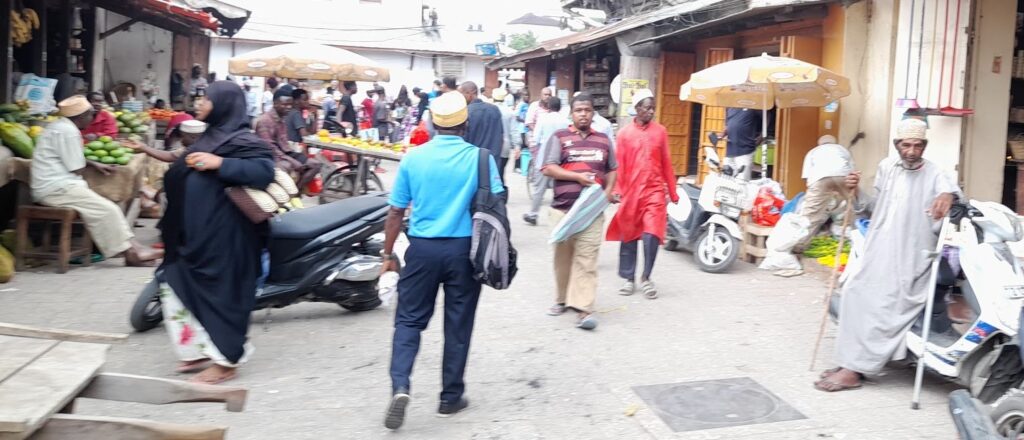
Some things to get a picture of: traditional buildings have a baraza, a long stone bench for resting or socializing along the outside walls; it’s an elevated sidewalk if it rains too much. Most buildings have large verandas (look up) protected by carved wooden balustrades. The  town is a maze of narrow alleys and most streets are too narrow for cars, so it’s crowded with bicycles and motorbikes. Darajani Market, which has been around since 1904, is on the edge of Stone Town, extending to the wider street along the seafront. Another interesting market – actually a giant open-air restaurant
town is a maze of narrow alleys and most streets are too narrow for cars, so it’s crowded with bicycles and motorbikes. Darajani Market, which has been around since 1904, is on the edge of Stone Town, extending to the wider street along the seafront. Another interesting market – actually a giant open-air restaurant 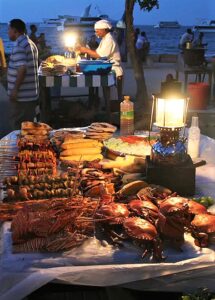 – is in Forodhani Park, right on the waterfront. Every night food stalls set up there to serve every kind of seafood you can imagine; people come in droves (locals and tourists alike); hey, Anthony Bourdain did a feature on it; he had octopus! Did I get my Zanzibarian coffee today? I did indeed, in an authentic Arabic house constructed in 1885 by Sir Tharia Topan, Wazir to Sultan Said Barghash. A wazir is an aide, or minister, by the way. More on sultans coming up.
– is in Forodhani Park, right on the waterfront. Every night food stalls set up there to serve every kind of seafood you can imagine; people come in droves (locals and tourists alike); hey, Anthony Bourdain did a feature on it; he had octopus! Did I get my Zanzibarian coffee today? I did indeed, in an authentic Arabic house constructed in 1885 by Sir Tharia Topan, Wazir to Sultan Said Barghash. A wazir is an aide, or minister, by the way. More on sultans coming up.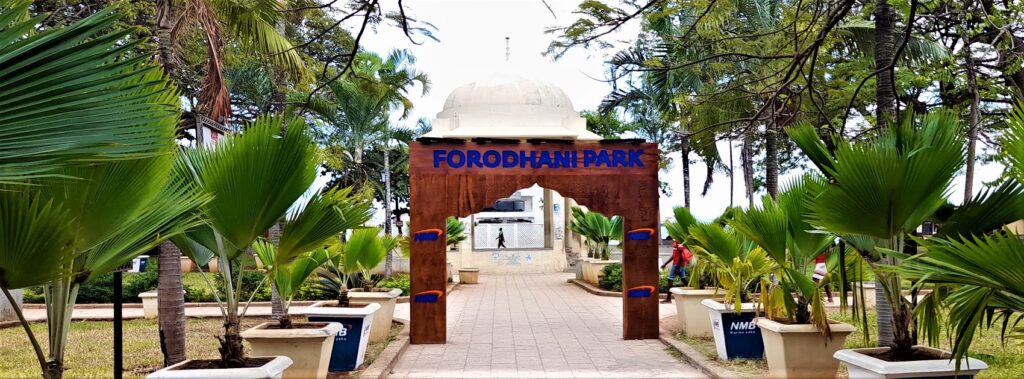
Can you find our guide Said? He’s wearing the gold hat (kufi) and the blue shirt.
“To Market, To Market” is a folk nursery rhyme based upon the traditional rural activity of going to a market where agricultural products would be bought and sold. Typically chanted when bouncing baby on your knee, it came to mind while I was walking “the market” today.
- To market, to market, to buy a fat pig,
- Home again, home again, jiggety-jig.
- To market, to market, to buy a fat hog,
- Home again, home again, jiggety-jog.
- To market, to market to buy a plum cake,
- Home again, home again, market is late.
- To market, to market, to buy a plum bun,
- Home again, home again, market is done.
Zanzibar Serena Hotel https://www.serenahotels.com/zanzibar
Zanzibar Coffee House https://www.utengule.com/zanzibar-coffee-house
Fisherman’s Tours https://fishermantours.com/
Next Post: Sultans and Slavers
» posted on Monday, September 26th, 2022 by Linda Lou Burton
Freddie & The Doors
Linda Lou Burton posting from Zanzibar Serena Hotel, Stone Town, Zanzibar, Tanzania –  Is this going to be a post about rock stars? Well yes, and no. Those of a certain generation might think “rock stars” when you see The Doors; likewise when you see the name Freddie. Freddie Mercury. Queen. The Doors. They were the noise of the 60s, and onward; controversial and influential, changing music and leaving behind songs that stick with us to this day. And they were flamboyant! So it was a bit of a surprise to realize our hotel was just around the corner from the Freddie Mercury museum in Stone Town, Zanzibar, a city steeped in traditions that go back to Medieval times. Freddie didn’t BECOME a rock star in this setting, but he was BORN in Stone Town on September 5, 1946, as Farrokh Bulsara to
Is this going to be a post about rock stars? Well yes, and no. Those of a certain generation might think “rock stars” when you see The Doors; likewise when you see the name Freddie. Freddie Mercury. Queen. The Doors. They were the noise of the 60s, and onward; controversial and influential, changing music and leaving behind songs that stick with us to this day. And they were flamboyant! So it was a bit of a surprise to realize our hotel was just around the corner from the Freddie Mercury museum in Stone Town, Zanzibar, a city steeped in traditions that go back to Medieval times. Freddie didn’t BECOME a rock star in this setting, but he was BORN in Stone Town on September 5, 1946, as Farrokh Bulsara to  Indian-born parents Bomi and Jer Bulsara. Bomi was a cashier at the British Colonial Office in Stone Town; Zanzibar was a British Protectorate at the time. Farrokh spent most of his school years in India, coming back to Zanzibar in 1963 to be with his parents; but in spring of 1964 the family fled to England to escape the violence of the revolution against the Sultan of Zanzibar and the mainly Arab government. Farrokh changed his name to Freddie Mercury in England and you know the rest of that story. (Or not.) The Museum was opened in Zanzibar November 24, 2019, commemorating the 28th anniversary of Freddie’s death.
Indian-born parents Bomi and Jer Bulsara. Bomi was a cashier at the British Colonial Office in Stone Town; Zanzibar was a British Protectorate at the time. Farrokh spent most of his school years in India, coming back to Zanzibar in 1963 to be with his parents; but in spring of 1964 the family fled to England to escape the violence of the revolution against the Sultan of Zanzibar and the mainly Arab government. Farrokh changed his name to Freddie Mercury in England and you know the rest of that story. (Or not.) The Museum was opened in Zanzibar November 24, 2019, commemorating the 28th anniversary of Freddie’s death.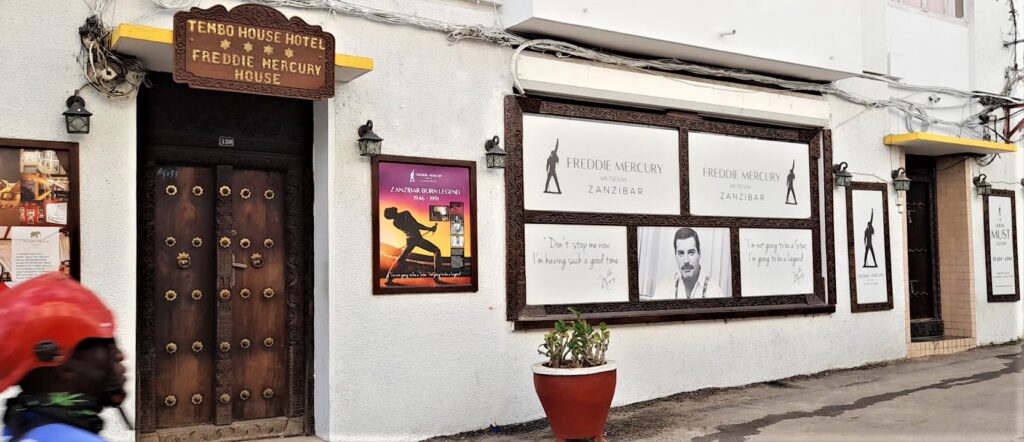
“We can walk there together later on our own,” we agreed this morning as Rick headed out to begin his organized City Walking Tour. Well, we didn’t. But Rick walked past it on his tour, and I rode past it in the tour van later. Ha! At least we both saw the beautiful DOOR out front.
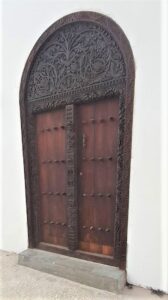 NOW TO THE DOORS: Zanzibar is FAMOUS for its DOORS! As it should be; they are elegant, intricate, beautiful, and long-lasting bits of “history we like to look at.” Fortunately, craftsmen and artists and entrepreneurs will make one for you in this day and time, for a price of course. Rick and I were just intent on looking AT them today, and thinking about events that took place on either side of them. What stories they could tell! The buildings in Stone Town are old; the streets and alleyways are narrow and crowded. We both took photos; of doors surrounded by people, cats, cars, life in a hurry or life over a cup of coffee. I give you a few descriptive bits (don’t get bored) about the meaning of the designs, see what you can pick out on the photos of the doors we saw. How old would you guess each door to be? Consider this:
NOW TO THE DOORS: Zanzibar is FAMOUS for its DOORS! As it should be; they are elegant, intricate, beautiful, and long-lasting bits of “history we like to look at.” Fortunately, craftsmen and artists and entrepreneurs will make one for you in this day and time, for a price of course. Rick and I were just intent on looking AT them today, and thinking about events that took place on either side of them. What stories they could tell! The buildings in Stone Town are old; the streets and alleyways are narrow and crowded. We both took photos; of doors surrounded by people, cats, cars, life in a hurry or life over a cup of coffee. I give you a few descriptive bits (don’t get bored) about the meaning of the designs, see what you can pick out on the photos of the doors we saw. How old would you guess each door to be? Consider this:
- The Swahili or Zanzibari doors were developed during the Middle Ages.
- The oldest are found along the East African coast from Mozambique to Kenya.
- The highest concentration of remaining doors is in Zanzibar’s Stone Town.
- They were created for the wealthy: sultans and slave traders and caravan traders.
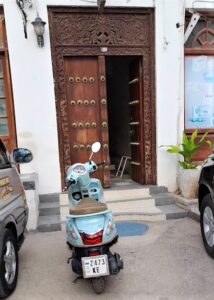 The Swahili designs are divided into two types; the classic rectangular is more geometric with more pre-Islamic forms; with motifs of lotus, rosettes, chain, date palms, and fish. Later designs changed to arched lintels; these doors have more floral patterns due to Indian inspiration as more Indian immigrants came to East Africa. The chain was replaced with beads on the frame; the fish became a vase with vines. The center of the lintel in both the rectangular and arched style usually has an Arabic inscription – a quote from the Koran, the date of completion of the door, or the owner’s initial and/or name. The doors themselves are not carved, instead, they are studded with metal tiers usually made of Brass or cast iron. The wood used for the most expensive doors is African ebony or imported teak.
The Swahili designs are divided into two types; the classic rectangular is more geometric with more pre-Islamic forms; with motifs of lotus, rosettes, chain, date palms, and fish. Later designs changed to arched lintels; these doors have more floral patterns due to Indian inspiration as more Indian immigrants came to East Africa. The chain was replaced with beads on the frame; the fish became a vase with vines. The center of the lintel in both the rectangular and arched style usually has an Arabic inscription – a quote from the Koran, the date of completion of the door, or the owner’s initial and/or name. The doors themselves are not carved, instead, they are studded with metal tiers usually made of Brass or cast iron. The wood used for the most expensive doors is African ebony or imported teak.
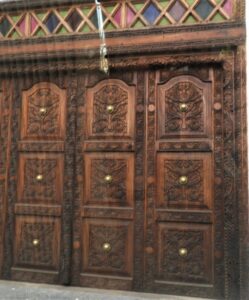
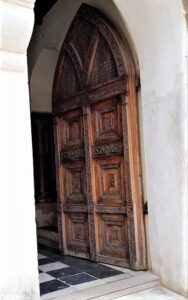
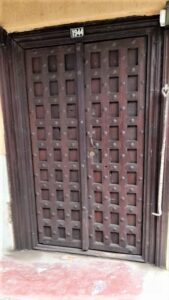

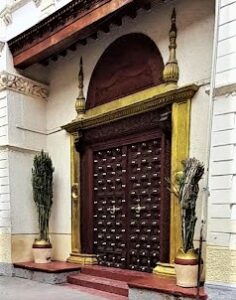
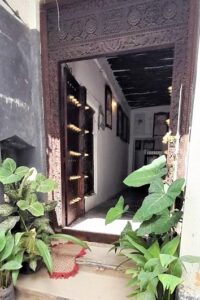
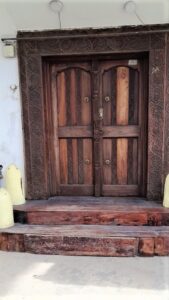
Zanzibar Serena Hotel https://www.serenahotels.com/zanzibar
Fisherman’s Tours https://fishermantours.com/
Freddie Mercury Museum https://freddiemercurymuseum.com/
Next Post: To Market, To Market

